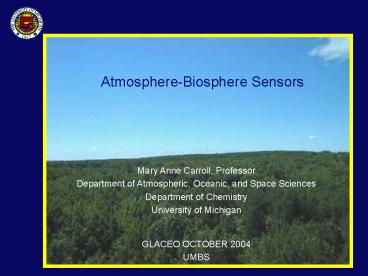AtmosphereBiosphere Sensors - PowerPoint PPT Presentation
1 / 25
Title: AtmosphereBiosphere Sensors
1
Atmosphere-Biosphere Sensors
Mary Anne Carroll, Professor Department of
Atmospheric, Oceanic, and Space
Sciences Department of Chemistry University of
Michigan GLACEO OCTOBER 2004 UMBS
2
A suite of strategies to meet objective
- Instrument and model development,
characterization, and intercomparisons - Improved quantification of experimental and
modeling data uncertainties - Interdisciplinary approach for integrated field
studies - Involvement of modelers in design of measurement
programs - Simultaneous measurements of large number of
chemical species fluxes required to quantify /
complete budgets. - Coupled with simultaneous measurements of key
ecological parameters - Open-air / chamber fumigation / manipulation
studies (including isotopic labeling) - Observation and model product intercomparisons
3
Key Issues / Challenges
sufficiently small sensors to avoid perturbing
turbulence sufficiently sensitive sensors with
fast time response wall-less inlets
generation and maintenance of suite of standards
for instrument characterization and
intercomparisons sufficient number of sensors
for meaning spatial coverage tools for scaling
up from point / local measurements to ecosystem
scale fully coupled, quantative
parameterizations of key processes (e.g.,
boundary layer dynamics plant physiology soil
microbiology atmospheric chemistry ) new
paradigm for studying effects of mutiple stressors
4
Leveraging Opportunities
heightened interest in air quality
forecasting some overlap with
Biosphere-Atmosphere Sensing needs many
agencies generating plans for their contributions
to the global earth observing system consider
adding ambient and flux measurements to existing
tower sites partner with institutions /
agencies / commercial entities to increase use of
airborne platforms
5
Sensors!
example of sensors used to examine effects of
ozone exposure and deposition on emissions of
isoprene example of converter-sensor
couplings suite of sensors deployed for a
study of atmosphere-forest exchange of reactive
nitrogen strategy for measuring fluxes with
slower sensors up and coming sensors (but
still waaay too big!)
6
Primary and secondary foci
7
CHEMILUMINESCENCE DETECTORS
Fast response (gt 1 Hz) Linear response over
low pptv - ppm range Extremely sensitive (very
low detection limits) Selectivity varies
General premise A B C
D C C hn
Measure photons1
1Photomultiplier tube followed by pulse amplifier
discriminator or electrometer
8
Chemiluminesce detector built in the mid 1980s
for airborne measurements of NO
Dry ice / cold probe housing for PMT
Gold-plated reaction vessel 10 torr
PAD
Teflon zero volume
Teflon water volume
9
Photolytic Converter built in the mid 1980s for
airborne measurements of NO2
T- controlled ( 0 C) glass cell
Xe Arc lamp
Deflecting/pass through mirror
10
Multichannel instrument built in 1996 for
airborne measurements of NO and NO2 now in use at
PROPHET Tower for O3 and NOx flux measurements
- UM Multichannel Chemiluminescence Instrument
(UMMCI) - O3
- NO
- NO2 (photolytically converted to NO)
- NOy (catalytically converted to NO)
- chemiluminescence
- O3 NO ? NO2 O2
- NO2 ? NO2 h?
- NO reaction vessels
- 230 cm3 volume
- 0.16 s flush at 1 slpm
- near 3 Hz data
11
Catalytic Converter built in the late 1990s for
tower measurements of NOy
Gold-tubes (300 - 500 C)
HNO3 Permeation Oven
Mini valves for standard addition calibrations
12
(No Transcript)
13
Eddy covariance fluxes
- sonic anemometer
- assumptions
- uniform, horizontal surface
- no advective effects
- no sources or sinks between the sensor and the
canopy - mean vertical velocity is zero
- concentration does not change significantly with
time
14
Ozone and Isoprene Fluxes
Fast isoprene sensor Also chemiluminescence Detect
or using O3.
15
Flux Measurements Using Relaxed Eddy
Accumulation when sensors are not fast enough
Westberg et al., 2001
16
Application of the Relaxed Eddy-Accumulation
Technique
- Fluxes of Greenhouse gases (CH4, N2O, CO2)
- REA-Stainless-Steel Canister system
- REA-Bag (Teflon) system
- Fluxes of Semi-volatile organic compounds
(herbicides) - REA-PUF (Polyurethane Foam) system
- REA-Sorbent System
- Fluxes of Volatile organic compounds (isoprene)
- REA-Stainless-Steel Canister system
- REA-Bag (Teflon) system
- REA-Sorbent System
- Fluxes of Ammonia
- REA-Denuder system
17
Reactive Nitrogen Oxide Species Sensors
- NO
- NO2
- peroxyacetyl nitrate (PAN)
- peroxypropionyl nitrate (PPN)
- other peroxyacyl nitrates
- HONO
- HO2NO2
- NO3
- N2O5
- organic nitrates and hydroxynitrates
- HNO3
- aerosol nitrate and nitrite
NOx
can be transported long distances
GC/ECD
NOy
Various wet chemistry methods
major NOx oxidation product wet and dry
deposition sinks
GC/ECD, GC/MS
Ion chromatography, CIMS
Aerosol MS
Thornberry 2001, Vitousek 1997
18
Up and coming methods for reactive nitrogen
species measurements
CIMS Chemical Ionization Mass Spectrometry
TDL Tunable Diode Laser Trace Gas Detectors
AMS Aerosol Mass Spectrometry
19
Chemical Ionization Mass Spectrometer
Measurements of Peroxy Radicals and HNO3
(Huey et al., PROPHET 2001 measurements of OH,
HO2, and HNO3)
20
Tunable Diode Laser Infrared absorption
measurement of trace gases such as CH4, C2H6,
CH2O, N2O, SO2, H2O2, NO, NO2, HNO3, NH3, O3,
CO2, HOCl and HCl. (Horii et al. Harvard Forest
Measurements of NO2 and HNO3 fluxes) Zahniser
et al.
21
Aerosol Mass Spectrometer Fast, continuous
measurements of fine aerosol non-refractory
chemical composition and size resolved particle
mass distributions as a function of particle
composition. (Worsnop et al. PROPHET 2001
measurements of aerosol compositon with focus on
nitrate)
22
Most of our most sensitive and fast-response
sensors are still a wee bit too big to allow
deplolyment on small aircraft!
Figure by Mike Martins
23
And many are too large to allow placement of
several on top of towers without significant
perturbation of turbulence
PROPHET Tower at UMBS
24
Please visit the PROPHET Laboratory while youre
here!
25
(No Transcript)































